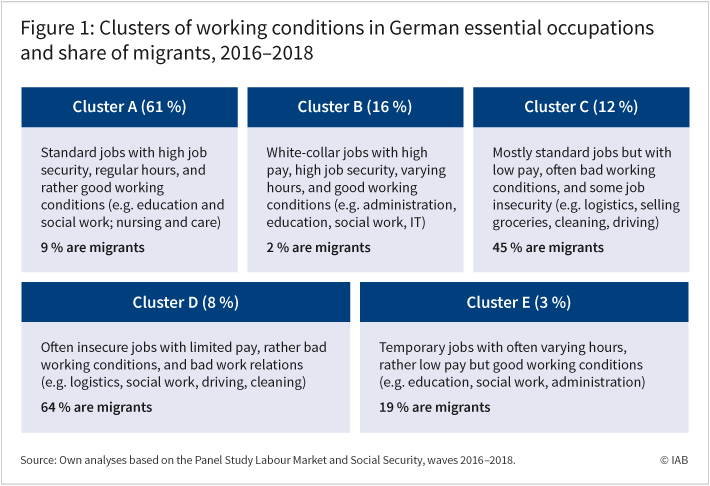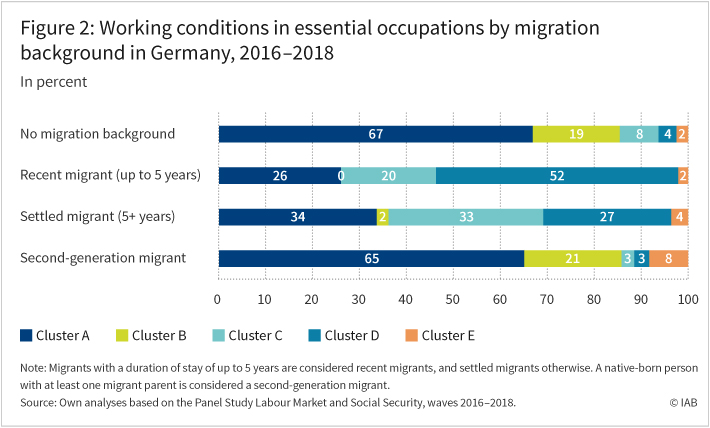9. August 2022 | Series "Covid-19 crisis: consequences for the labour market"
Essential occupations: what are the working conditions like?

During the Covid-19 pandemic, a number of “essential” or “system-relevant” occupations emerged which, during the lockdowns, were not subject to the limitations that other occupations faced. Most essential occupations were to be found in health care, social care, agriculture, energy supply, water and waste management, transport as well as wholesale and retail of certain goods such as food. Working conditions in these occupations may be very heterogeneous.
A key concern is that bad working conditions in essential occupations could lead to high employee turnover, as documented for nurses in a study by Maura Galletta, Igor Portoghese, and Adalgisa Battistelli from 2011. Then valuable knowledge would be lost at a high rate, and with short time horizons, too little would be invested in the skills of new staff. Temporary or permanent staff shortages may arise, which likely affects the quality of services such as healthcare, and leads to these occupations being much more vulnerable to crises like the Covid-19 pandemic.
Something that has received considerable attention during the pandemic is the high share of migrants in some essential occupations. While migrants are often employed in jobs with adverse occupational exposures and working conditions, such as logistics and cleaning, the pandemic highlighted their strong role in maintaining core functions of the economy and society.
Working conditions in essential jobs in Germany are overall good, but there are some exceptions
New research at the IAB and the European University Institute takes a close look at the individual working conditions in essential occupations in Germany and the role of migrants. Applying statistical classification to job characteristics that describe individual working conditions, the study identifies five clusters of jobs, each accounting for a share of all jobs in essential occupations (s. Figure 1). Standard jobs (i.e. full-time, with permanent contract) with rather good working conditions (Cluster A) alone account for 61 percent. White-collar jobs with good working conditions (Cluster B) account for another 16 percent. Mostly standard jobs with bad working conditions (Cluster C) still account for 12 percent, and often temporary jobs with rather bad working conditions (Cluster D) make up 8 percent. Another 3 percent of jobs in essential occupations (Cluster E) are generally temporary but offer better working conditions.
In Cluster A, around 90 percent of employees have a permanent contract and fixed work schedule. Almost two-thirds of employees in this cluster are women, and more than two-thirds work in the private sector. Only 5 percent of employees in Cluster A indicate having job insecurity. Frequent occupations include education and social work (18 % of employees in Cluster A), nursing (15 %), warehousing and logistics (14 %), and geriatric care (9 %). Large majorities report having opportunities to learn (83 %) and to master difficult tasks (80 %), while 33 percent report a lack of autonomy. According to additional data on tasks and job characteristics in occupations from the Federal Institute for Vocational Education and Training (s. infobox “Methods and data”), tasks in Cluster A often include giving advice or information (63 %) or convincing others (44 %) but also often involve repetitive tasks (56 %).

Employees in Cluster B often receive high wages (70 %), and virtually all have a permanent contract. At the same time, working hours are generally flexible, and 78 percent report that overtime is common. Men and women are roughly equally represented in this cluster, and half work in the public sector (52 %). The main occupations are public administration (30 %), education and social work (24 %), driving (8 %) as well as information technology (7 %). Very few (4 %) report a lack of autonomy in their work; virtually everyone reports having opportunities to learn and to master difficult tasks. Only 25 percent report that their tasks are strongly codified, and the data on tasks suggest that giving advice and information are integral tasks for two-thirds in this cluster.
While employees in Cluster C also exhibit high shares with permanent contracts (82 %) and fixed working hours (99 %), low hourly wages are far more frequent in Cluster C (83 %) than in other clusters. Half of the jobs in this cluster are part-time (less than 35 hours per week), and 86 percent work in the private sector. The most frequent occupations are warehousing and logistics (20 %), selling groceries (19 %), cleaning (16 %) and driving (11 %). Most report poor prospects for advancement (75 %), lack of challenging tasks (64 %) and a lack of autonomy at work (63 %, by far the highest of all clusters). Tasks are especially often codified (38 %) and repetitive (66 %).
Cluster D features almost exclusively medium-level wages (95 %). While 36 percent of these jobs are part-time, two in five contracts are temporary, and the share of jobs that are considered insecure (64 %) is higher than in all other clusters. Most employees (70 %) work in the private sector, half of them are women, and especially many have children (61 %). Frequent occupations include warehousing and logistics (28 %), education and social work (24 %), driving (13 %), and cleaning (8 %). Two in five do not find their tasks challenging, close to half (47 %) report having little autonomy, and many see poor prospects for advancement (73 %). In Cluster D, far more employees than in other clusters have poor work relations with their supervisors (48 %) and/or colleagues (26 %).
Finally, virtually all employees in Cluster E have temporary contracts, and half of them work part-time while overtime is common (83 %). Almost half of the jobs are in the public sector. Main occupations are education and social work (26 %), public administration (23 %), warehousing and logistics (16 %) as well as farming (7 %). In this cluster, the pace of work is comparatively often determined by equipment (31 %).
Poor working conditions lead to higher employee turnover
Although working conditions in essential occupations are mostly good or average, the results also confirm a central concern: comparatively poor working conditions in Clusters C and D coincide with comparatively low job tenure, a potential risk for high employee turnover. This could undermine the resilience of basic services that essential occupations provided during the crisis as argued in a 2021 study by Bridget Anderson, Friedrich Poeschel, and Martin Ruhs. While the average tenure with the current employer is 10 years in Cluster A and 13 years in Cluster B, it is around 6 years in Clusters C and D. Accordingly, temporary contracts are substantially more frequent in Cluster C and especially Cluster D. With hardly any permanent contracts in Cluster E, average job tenure there is under 3 years.
Jobs in Clusters C and D are more often “dull”, as compared with other clusters. Clusters C and D typically exhibit the highest shares of jobs that involve repetitive motions, bending or twisting. At the same time, Clusters C and D exhibit the lowest shares of jobs that leave workers the freedom to make their own decisions or involve such tasks as convincing, advising, or informing.
Migrants often work in jobs with bad working conditions
Migrants are overrepresented in Clusters C and D where working conditions are rather bad (s. Figure 2). While only 12 percent of those without a migration background work in these clusters, this share rises to 60 percent for settled migrants and more than 70 percent for recent migrants in essential occupations. In particular, half of the recent migrants work in Cluster D, which arguably offers the worst working conditions, but they virtually never work in Cluster B, which arguably offers the best working conditions. Other findings that migrants are overrepresented in jobs with poor working conditions, e.g. by Tanja Fendel, Stefanie Gundert, and Yuliya Kosyakova in 2020, therefore also apply to the context of essential occupations, despite their critical relevance for basic services. Further analyses indicate that especially a lack of proficiency in the host-country language prevents migrants from obtaining better jobs, alongside other factors related to country of origin such as relevant work experience and the quality of education. By contrast, second-generation migrants exhibit a distribution over clusters similar to persons without a migration background.

Conclusions
The majority of jobs in essential occupations in Germany, including most jobs in health services, are standard jobs with average or good working conditions. Poor working conditions and routine tasks mostly arise in a few occupations, notably cleaning, logistics/warehousing, and certain forms of care. However, “good” and “bad” jobs coexist within the same occupation. In this context, even a share of 20 percent in “bad” jobs may be extremely problematic: by generating high staff turnover or permanent shortages, this could undermine the resilience of basic services that essential occupations provide during crises. Those jobs with poor working conditions exhibit high shares of migrants. This overrepresentation, known from other sectors, therefore also applies to the context of essential occupations, despite their critical relevance for basic services. In order to ensure the resilience of basic services during crises, policies should pay more attention to working conditions in essential occupations. This concerns institutions that may encourage adoption of good work practices and foster employee-employer dialogue (such as trade unions), as well as various policies that shape essential occupations. But it also concerns migration policy such as assessment and recognition of foreign qualifications, due to the particular role that migrants seem to play in essential occupations.
Methods and data
The analysis is based on the 2016-2018 waves of the “Panel Study Labour Market and Social Security” (PASS), a longitudinal survey that covers about 10,000 households in Germany. Designed for researching labour market and welfare issues, the survey provides unusually rich information on working conditions. In addition, data on individual occupational tasks (with multiple answers possible) were obtained from the Federal Institute for Vocational Education and Training (BIBB). This paper uses the first list of essential occupations drawn up by the state of Berlin on 17 March 2020 plus agricultural occupations that were included in more rural states as discussed in the 2020 study by Josefine Koebe et al. Job clusters were identified through a Latent Class (Cluster) Analysis (LCA), an empirical technique that uses relationships among variables to uncover underlying (“latent”) clusters in the data.
Literature
The analysis is based on the 2016-2018 waves of the “Panel Study Labour Market and Social Security” (PASS), a longitudinal survey that covers about 10,000 households in Germany. Designed for researching labour market and welfare issues, the survey provides unusually rich information on working conditions. In addition, data on individual occupational tasks (with multiple answers possible) were obtained from the Federal Institute for Vocational Education and Training (BIBB). This paper uses the first list of essential occupations drawn up by the state of Berlin on 17 March 2020 plus agricultural occupations that were included in more rural states as discussed in the 2020 study by Josefine Koebe et al. Job clusters were identified through a Latent Class (Cluster) Analysis (LCA), an empirical technique that uses relationships among variables to uncover underlying (“latent”) clusters in the data.
Anderson, Bridget; Poeschel, Friedrich; Ruhs, Martin (2021): Rethinking labour migration: Covid-19, essential work, and systemic resilience. In: Comparative Migration Studies 9, pp. 1–19.
Galletta, Maura; Portoghese, Igor; Battistelli, Adalgisa (2011): Intrinsic Motivation, Job Autonomy and Turnover Intention in the Italian Healthcare: The mediating role of Affective Commitment. In: Journal of Management Research, Vol 3, No 2.
Gundert, Stefanie; Kosyakova, Yuliya; Fendel, Tanja (2020): Migrantinnen und Migranten am deutschen Arbeitsmarkt: Qualität der Arbeitsplätze als wichtiger Gradmesser einer gelungenen Integration. IAB-Kurzbericht No. 25.
Koebe, Josefine; Samtleben, Claire; Schrenker Annekatrin; Zucco, Aline (2020): Systemrelevant, aber dennoch kaum anerkannt: Entlohnung unverzichtbarer Berufe in der Corona-Krise unterdurchschnittlich. DIW Aktuell, No 28.
Nivorozhkin, Anton; Poeschel, Friedrich (2022): Working conditions in essential occupations and the role of migrants. In: Economic Analysis and Policy, Vol. 74, pp. 250-261.
In brief
The Covid-19 pandemic raised important questions on working conditions in system-relevant occupations. Poor working conditions may generate high staff turnover or permanent shortages, and this could undermine the resilience of basic services that system-relevant occupations provide during crises.
Recent results for Germany show that while a majority of workers in system-relevant occupations have standard or good working conditions, some are employed in jobs that offer low pay and job security as well as little autonomy and poor prospects. First-generation migrants are especially often found in jobs with bad working conditions.
To ensure the resilience of basic services, policy makers should pay close attention to working conditions. Policies could improve working conditions directly through regulation or indirectly through raising skills and life-long learning.
DOI: 10.48720/IAB.FOO.20220809.02
Nivorozhkin, Anton; Poeschel, Friedrich (2022): Essential occupations: what are the working conditions like?, In: IAB-Forum 9th of August 2022, https://www.iab-forum.de/en/essential-occupations-what-are-the-working-conditions-like/, Retrieved: 19th of April 2024
Authors:
- Anton Nivorozhkin
- Friedrich Poeschel

 Anton Nivorozhkin is senior researcher in the department "Joblessness and Social Inclusion" at the IAB.
Anton Nivorozhkin is senior researcher in the department "Joblessness and Social Inclusion" at the IAB. Friedrich Poeschel is senior analyst in the Asylum Knowledge Centre of the European Union Agency for Asylum in Malta.
Friedrich Poeschel is senior analyst in the Asylum Knowledge Centre of the European Union Agency for Asylum in Malta.